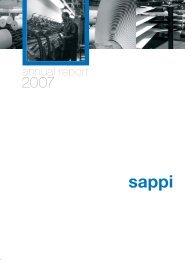2012 Integrated report - Sappi
2012 Integrated report - Sappi
2012 Integrated report - Sappi
Create successful ePaper yourself
Turn your PDF publications into a flip-book with our unique Google optimized e-Paper software.
External<br />
assurance<br />
providers<br />
Reporting<br />
Principle<br />
Chapter 4 – Governance of risk<br />
The board’s<br />
responsibility<br />
for risk<br />
governance<br />
Management’s<br />
responsibility<br />
for risk<br />
management<br />
Risk<br />
assessment<br />
3.9. The audit committee is<br />
responsible for recommending<br />
the appointment of the<br />
external auditor and<br />
overseeing the external<br />
audit process<br />
3.10. The audit committee should<br />
<strong>report</strong> to the board and<br />
shareholders on how it has<br />
discharged its duties<br />
4.1. The board should be<br />
responsible for the governance<br />
of risk<br />
4.2. The board should determine<br />
the levels of risk tolerance<br />
4.3. The risk committee or audit<br />
committee should assist<br />
the board in carrying out its<br />
risk responsibilities<br />
4.4. The board should delegate<br />
to management the<br />
responsibility to design,<br />
implement and monitor<br />
the risk management plan<br />
4.5. The board should ensure<br />
that risk assessments<br />
are performed on a<br />
continual basis<br />
4.6. The board should ensure<br />
that frameworks and<br />
methodologies are<br />
implemented to increase<br />
the probability of anticipating<br />
unpredictable risks<br />
Risk response 4.7. The board should ensure that<br />
management considers and<br />
implements appropriate risk<br />
responses<br />
Risk monitoring 4.8. The board should ensure<br />
continual risk monitoring by<br />
management<br />
Risk assurance 4.9. The board should receive<br />
assurance regarding the<br />
effectiveness of the risk<br />
management process<br />
Risk disclosure 4.10. The board should ensure that<br />
there are processes in place<br />
enabling complete, timely,<br />
relevant, accurate and<br />
accessible risk disclosure to<br />
stakeholders<br />
Summary of how <strong>Sappi</strong> applies the King III principles<br />
The audit committee has responsibilities for and oversight of the external audit<br />
activities, including their appointment, qualifications, independence, approach,<br />
<strong>report</strong>ing and performance<br />
The audit committee <strong>report</strong>s to the board as well as to the shareholders on how it<br />
has discharged its duties. The audit committee’s <strong>report</strong> to stakeholders is included<br />
in the integrated <strong>report</strong><br />
The board is responsible for the governance of risk at <strong>Sappi</strong>, assisted by the<br />
group risk management team and the audit committee<br />
The board considers and determines the levels of risk tolerance as well as risk<br />
appetite during its periodic review of the group’s risk profile. In executing the group<br />
strategy, management considers risk tolerance and appetite for specific risks and<br />
projects, on a case-by-case basis<br />
The board has appointed the audit committee to assist in carrying out its risk<br />
responsibilities by providing oversight of <strong>Sappi</strong>’s risk management activities<br />
The board has delegated the responsibility to design, implement and monitor<br />
<strong>Sappi</strong>’s risk management plan, to the group risk management team<br />
Management performs risk assessments on a continual basis and provides regular<br />
feedback to the audit committee and the board<br />
Risk management meetings comprise multi-disciplinary teams. This together with<br />
<strong>Sappi</strong>’s framework and risk methodology increases the probability of anticipating<br />
unpredictable risks<br />
<strong>Sappi</strong>’s risk methodology includes the consideration and implementation of<br />
appropriate risk responses<br />
Risk monitoring is achieved at <strong>Sappi</strong> through a combination of daily and periodic<br />
activities undertaken by management at various levels in the organisation,<br />
culminating in the activities of the group risk management team and audit<br />
committee, which oversee the risk management process at <strong>Sappi</strong><br />
Assurance regarding the effectiveness of the risk management process is provided<br />
by both management and internal audit to the audit committee and board<br />
The relevant risks for the group are disclosed to stakeholders in the integrated<br />
<strong>report</strong>, the <strong>report</strong> on form 20F and the group and regional sustainability <strong>report</strong>s<br />
sappi <strong>Integrated</strong> Report <strong>2012</strong> 77
















